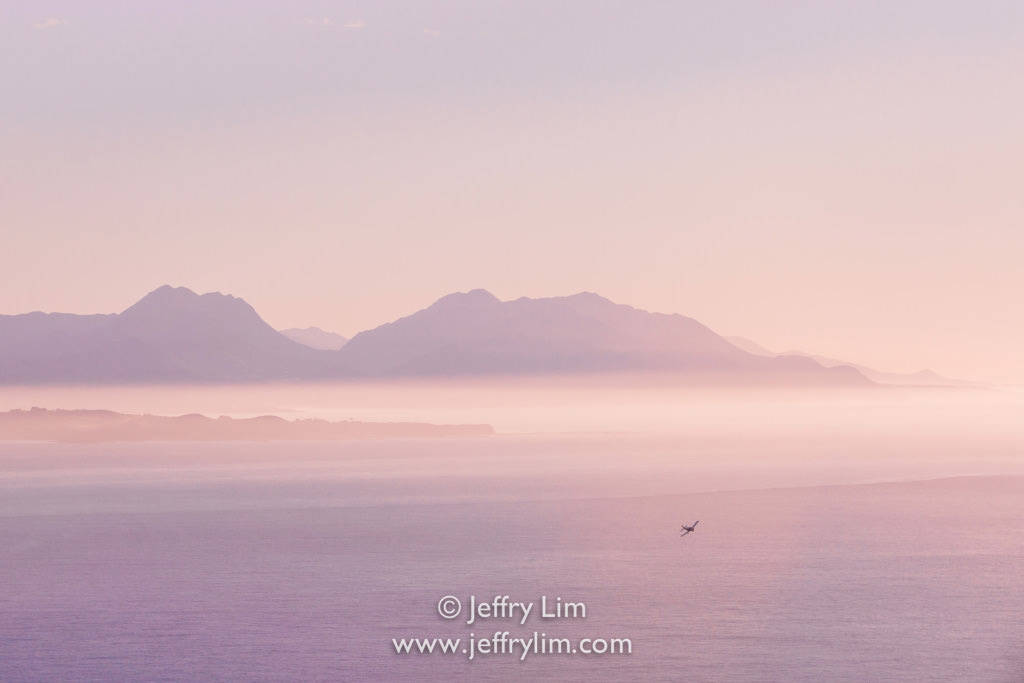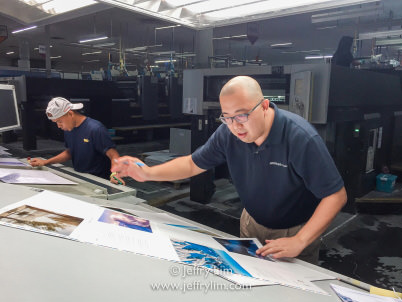The Allure of Aerial Photography: Capturing Unpredictable Landscapes Under Challenging Conditions
Allowing us to see the world from a drastically different perspective, aerial photography can be a challenging, but highly rewarding process. In the following interview, professional photographer Jeffry Lim gives some valuable advice and tips on what it takes to engage in aerial photography.

EOS 5D Mark III/ EF24-70mm f/2.8L II USM/ FL: 38mm/ Shutter-priority AE (f/3.5, 1/1600 sec)/ ISO 800/ WB: Auto
Aerial photography exhibition well-received in Malaysia

Over 50 large-size photos were featured at Jeffry Lim’s photo exhibition 'Aspiring New Zealand', held in Kuala Lumpur, Malaysia.
Held from 26 April until 7 May 2017, at the Bangsar Shopping Centre in Kuala Lumpur, Malaysia, the photo exhibition 'Aspiring New Zealand' featured a collection of over 50 large-size photos, taken by Malaysian professional photographer Jeffry Lim during his journey to New Zealand in June of 2016.
How long did the shoot for this exhibition take? Also, could you share with us some of the difficulties you encountered?
The shoot took about 23 days. Some of the difficulties encountered include extreme cold weather, flight turbulence, strong winds, lack of sunlight, and information about the shooting locations (as these locations are not the usual tourist spots). It was also a challenge to try out new skills when shooting from a different type of airplane. Also, at times the weather up in the sky can be hazy, making it difficult to shoot, which requires additional waiting time until the sky clears.
Did you have to apply for any special permits for your shoot?
In New Zealand you have the option to engage in aerial photography using light aircrafts, without the special permit application process that is required by other countries, which normally make it difficult to shoot aerial photos.

EOS 5D Mark III/ EF24-70mm f/2.8L II USM/ FL: 70mm/ Shutter-priority AE (f/5, 1/1250 sec)/ ISO 800/ WB: Auto
Harvest Land (Kaikoura Flat): a vertical shot showing a breathtaking green view of farm land that provides bountiful harvest.
Did you encounter any dangerous situations while you were shooting?
Yes, as most shots were taken with the airplane door fully opened, the motion at high altitude and the turbulence during strong wind conditions made it harder to maintain my balance, and that made me feel quite vulnerable.
Could you share with us an anecdote of the most miraculous thing that happened during your shoot?
I had dreamt about the word ‘Aspiring’, and in various locations I visited, the word appeared on signage. It seemed to prompt me to search for it. After doing some research online, I discovered Mount Aspiring by chance and decided to do an aerial shoot in New Zealand. The flight was a difficult one, as it was affected by constant strong turbulence, and there was not enough sunlight for a good shot. I started praying for divine intervention. After praying, a miracle happened as the sun began to appear from behind the clouds, and the mist that was covering the mountain view moved aside, revealing a clear peak for me to take a shot. It was breathtaking and amazing!

EOS 5D Mark III/ EF70-200mm f/2.8L IS II USM/ FL: 90mm/ Shutter-priority AE (f/4, 1/1250 sec)/ ISO 400/ WB: Auto
Majestic Abba (Mount Aspiring): in spite of the turbulent weather with little sunlight, a miracle happened as the sun suddenly appeared and the mist-covered mountain peak revealed itself.
The secret to successful aerial photography

Malaysian photographer Jeffry Lim geared up for his aerial shoot in New Zealand, in temperatures of -30 °C, at an altitude of 15,000 feet above sea level.
One of the many categories of photography, aerial photography is the action of taking photographs from an airborne platform, such as an aircraft, helicopter, kite, blimp, or unmanned aerial vehicle. Aerial photos can be divided into roughly two main types: "oblique", when it is shot looking down at an angle to the ground, and "vertical", when taken from directly overhead looking down. Aerial photography is one of Jeffry Lim’s key strengths, and fully competent in both types, he utilizes various angles appropriate for each subject.
Could you tell us about your first encounter with aerial photography, and what you find alluring about it?
When I was young, I took a ‘joyride’ trip on helicopter offered to families at a local event. It was from that trip that I discovered different perspectives of photography from above the sky.
What do you consider to be the most difficult thing when shooting from an airplane?
Unlike a helicopter, which can hover and stop at a specific location, a plane needs to fly constantly. Therefore, we only have one chance to capture a location from the same spot, which makes it a highly challenging feat to take good shots.
How long would one flight take during your shoots?
It ranges from 30 minutes to 2 hours, depending on the flight route and the area covered.

EOS 5D Mark III/ EF70-200mm f/2.8L IS II USM/ FL: 135mm/ Shutter-priority AE (f/14, 1/1600 sec)/ ISO 640/ WB: Auto
Serene (Conway Ridge): An early morning tranquil scene taken when flying above the deep open sea waters in search of whales and dolphins.
How would you typically prepare before a shoot (flight plan, etc.)? What is the process of visualization you go through before the final image is captured?
The first preparation is to ensure you have all the right photography equipment, safety harness, and enough warm clothing with you when you go onboard. The second is to have a basic flight route, and ensure that the plane has sufficient fuel to complete to journey. Unfortunately, we cannot specifically visualize the location until you actually fly to the targeted area, as nature is highly unpredictable and easily affected by elements such as the weather, wind, and sunlight condition, each of which can change rapidly.
What gear did you use during your shoot (cameras, lenses, filters, etc.)?
The camera I use is the EOS 5D Mark III, and the lenses I use are EF16-35mm f/2.8L II USM, EF24-70mm f/2.8L II USM, and EF70-200mm f/2.8L IS II USM. Additionally, I use polarizing filters.
What do you do to prevent camera shake when shooting handheld from a plane?
We cannot really prevent camera shake during the flight, but we can minimize the effect by shooting fast and shooting more. Setting your camera to high speed continuous shooting and using fast shutter speeds will help minimize image blurring.

EOS 5D Mark III/ EF24-70mm f/2.8L II USM/ FL: 44mm/ Shutter-priority AE (f/11, 1/1600 sec)/ ISO 800/ WB: Auto
Flow (Tasman River): a beautiful formation showing patterns formed by small streams, breaking out from the ice, flowing out in multiple directions.
The inspiration and motivation of a photographer

Jeffry Lim conducting a press check during the making of the ‘Aspiring New Zealand’ photography book, to ensure colour accuracy of his works.
Malaysian photographer Jeffry Lim has been professionally active in photography since 1995, and throughout the years has made aerial, industrial, offshore, and marine photography his key strength.
What was it that made you become a photographer?
I started as a student photojournalist for a local Chinese newspaper to make some pocket money. During this period, I practiced photography a lot and taught myself along the way. It was from there that I discovered I like photography and it gradually inspired me to become a professional photographer.
What do you consider the appeal and joy of landscape photography?
Landscape photography allows us to create different moods and feelings in the photos based on the season we shoot in. It is also about how we can connect to the landscapes and bring that experience back to the viewers.

EOS 5D Mark III/ EF24-70mm f/2.8L II USM/ FL: 50mm/ Shutter-priority AE (f/8, 1/1250 sec)/ ISO 400/ WB: Auto
Overcome (Macaulay River): the river, twisting and bending its way through different terrains, reflects how we can find solutions to overcome different challenges in life.
What do you normally feel when facing majestic landscapes? Do you have a different impression each time? Or does it bring to mind your theme?
Different natural elements create different things. Hence, all majestic landscapes are highly unpredictable, enabling us to create different beautiful shots.
You have been active in photography for a long time, but could you share with us your motivation?
I enjoy my photography journey, the passion, and skills blessed by God. I see myself as a messenger through visuals works and this motivates me.

EOS 5D Mark III/ EF24-70mm f/2.8L II USM/ FL: 28mm/ Shutter-priority AE (f/2.8, 1/1600 sec)/ ISO 800/ WB: Auto
Forest City (Motuariki Island): the early morning sunlight casts a shadow of the island trees, creating a silhouette resembling that of city skyscrapers.
In conclusion
Though aerial photography is fraught with difficulties and challenges, Jeffry Lim sees himself as visual storyteller, a messenger through visual works, which motivates him to engage in this category of photography, in his pursuit of capturing the beauty of nature for his audience to see. Through their understanding of magnificent subjects and their devotion to these subjects, photographers are able to summon courage and energy without limits, and as a result, are able to capture the most rewarding images.
Receive the latest update on photography news, tips and tricks.
Be part of the SNAPSHOT Community.
Sign Up Now!About the Author
A professional photographer with over 20 years of experience, Jeffry Lim has covered more than 40 countries for his assignments. He has a strong track record of clients in the oil and gas, industrial and corporate sectors, enabling him to develop a diverse photography experience, covering the sea, air, and land.
His work has been featured on television channels like National Geographic Channel and Discovery Channel, and in media such as National Geographic Traveler, and Associated Press (AP).



































